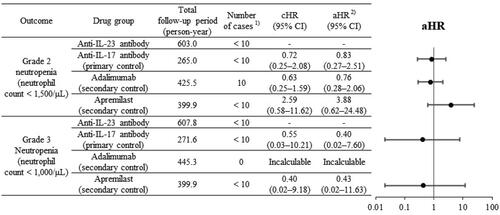Figures & data
Table 1. Summary of patient background at the baseline.
Figure 2. Comparison of neutropenia in anti-IL-23 antibody group with anti-IL-17 antibody, adalimumab, and apremilast groups.
CI: confidence interval, cHR: crude hazard ratio, aHR: adjusted hazard ratio, –: not applicable.
1: When the number of patients was <10, an aggregated value was presented based on the MID-NET® publication rule, so that a specific number could not be identified.
2: aHR, weighted by the inverse of the propensity score, which was estimated using a logistic regression model including covariates (see Supplementary Table S3 for the list of covariates considered in this study).

Table 2. Summary of results from the sensitivity analysis (anti-IL-23 antibody vs. anti-IL-17 antibody, adalimumab, or apremilast).
Supplementary file_final240606.docx
Download MS Word (503.9 KB)Data availability statement
The dataset generated in the study is not publicly available due to the terms of use for MID-NET® to which we adhered when conducting this study; the accessibility of the dataset used for this analysis is restricted to specific authors including the corresponding author in a predetermined secure environment. No outside researchers are allowed to access the dataset.

